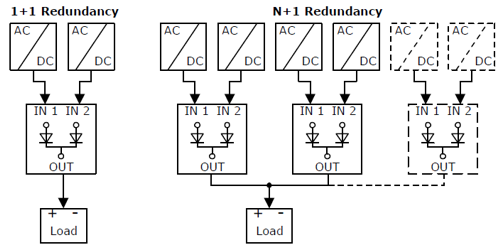Terminology and abbreviations
DC 24 V | A value preceded by AC or DC represents a rated voltage containing standard tolerances (normally ±15 %). |
24 Vdc | A value with the unit (Vdc) at the end is a momentary value that contains no tolerances. |
1+1 redundancy | Use of two identical power supply units in parallel in order to ensure continued operation after most failures of a single power supply unit. The two power supply outputs should be isolated from each other by the use of diodes or other switching devices. For example, two 10 A power supply units are required in order to achieve a redundant 10 A system. |
N+1 redundancy | Use of three or more identical power supply units in parallel in order to ensure continued operation after most failures of a single power supply unit. All power supply outputs should be isolated from one another by the use of diodes or other switching devices. Example: |
